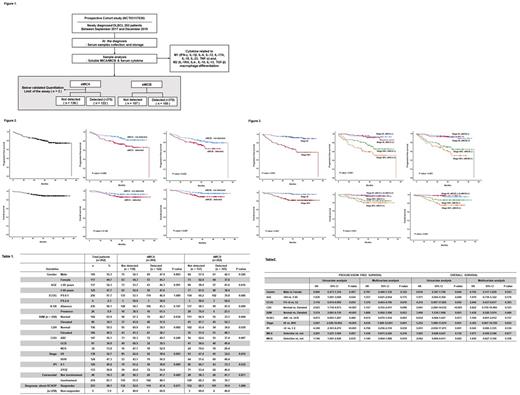Abstract
Background : Natural killer group 2 member D (NKG2D) and its ligands (MICA and MICB) play a vital role in recognizing target cells and lead to cell lysis through the cytotoxic functions in the cellular immune surveillance pathway. However, tumor cells cleavage the MICA and MICB from the cell membrane for immune escape using surface proteases. Thus, targeting sMICA/sMICB could be a basis for revealing the reasons for the immune escape of tumor cells and new resistance mechanisms of immunotherapy. However, it has not been studied in newly diagnosed diffuse large B cell lymphoma (DLBCL). So, we conducted the study to demonstrate the influence of sMICA/sMICB contributing to immune escape of newly diagnosed DLBCL.
Methods: The study population was the patients who were newly diagnosed with DLBCL between September 2017 and December 2019 and registered for the prospective cohort studies after providing written informed consent (NCT03117036). We collected the pretreatment characteristics and serum samples to determine sMICA/sMICB levels and cytokine analysis before the first chemotherapy (Figure 1). The levels of sMICA/sMICB were analyzed quantitatively by ELISA. All data were analyzed using the SPSS version 25.0 (IBM Corp, Armonk, NY, USA).
Results: The number of patients over 60 was 125 (47.7%), and 124 (47.3%) presented stage III or IV at the diagnosis. Among 262 patients, analysis of sMICA and sMICB was performed in 260 cases and 262 cases each. Of the 260 patient samples assessed for sMICA, 122 (46.9%) showed levels above LLOQ. Moreover, of 262 samples assessed for sMICB, 105 (40.1%) patients were above LLOQ. The percentage of the patients who showed elevated B2M (P-value of sMICA and sMICB = 0.034 and 0.004), elevated LDH (P-value of sMICA and sMICB = 0.002 and 0.030), the advanced stage (P-value of sMICA and sMICB = 0.003 and 0.012) and higher IPI risk group (P-value of sMICA or sMICB = 0.009 or 0.032) was statistically higher in the patients who showed sMICA/sMICB in serum (Table 1). Moreover, during the 34.7 (95% CI 32.0-37.4) months median follow-up period, the median PFS and OS were not reached. The median PFS of the patients who had positive sMICA (P-value = 0.006) or sMICB (P-value = 0.032) in the serum demonstrated poorer PFS. However, the median OS presented statistically similar in both groups. We further performed subgroup analyses according to the stage (stage I/II versus stage III/IV, Figure 2). Patients who detected sMICA or MICB even though the same stage showed poorer PFS and OS compared to those who did not (Figure 3). The clinical factors predicting poor PFS at univariate analysis were age (P-value = 0.024), elevated LDH (P-value < 0.001), elevated B2M (P-value < 0.001), advanced stage (P-value < 0.001), high IPI (P-value < 0.001), sMICA detection (P-value = 0.007) and sMICB detection (P-value = 0.035). In addition, the clinical factors predicting poor OS at univariate analysis were poor performance status (P-value = 0.050), elevated LDH (P-value < 0.001), elevated B2M (P-value =0.003), advanced stage (P-value < 0.001), and IPI (P-value < 0.001). However, the advanced stage retained the statistical significance in the multivariate analysis of PFS (P-value < 0.001, Table 2). In the cytokine analysis, TNF-α was detected more often in the patients who had detectable sMICA (P-value = 0.035) and sMICB (P-value = 0.044) levels. The IL-1RA (P-value = 0.013) and IL-10 (P-value = 0.005) were presented more often in patients who have detectable levels of sMICB (data not shown).
Conclusion: This is the largest study to date to evaluate the significance of sMICA and sMICB on the survival of newly diagnosed DLBCL. Furthermore, only a few studies had shown the level of sMICA and sMICB and not speculated on the correlation of disease course. Although we have not shown the correlation between cytokines and sMICA/sMICB conclusively, it will be conducted using immunostaining analysis of the tumor tissue samples. According to this study, the patients with sMICA/sMICB were about 40% more likely to progress to an advanced stage and high-risk IPI. Despite the same stage at diagnosis, the patients with detectable sMICA/sMICB showed poorer survival outcomes than those who did not. Further studies are needed to stratify the high-risk patients according to the detection of sMICA/sMICB., and more interest in adjusting more effective treatment to achieve extended survival outcomes is needed for these particular subsets of patients.
Disclosures
No relevant conflicts of interest to declare.
Author notes
Asterisk with author names denotes non-ASH members.


This feature is available to Subscribers Only
Sign In or Create an Account Close Modal